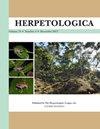华盛顿北太平洋响尾蛇种群的颜色变化、尾带和性别二色性
IF 1.1
3区 生物学
Q2 ZOOLOGY
引用次数: 0
摘要
摘要:北太平洋响尾蛇(Crotalus oreganus)是一种伏击捕食者,它们依靠隐蔽觅食和躲避捕食者,但对这种无处不在的响尾蛇物种的颜色变化知之甚少。本研究探讨了在华盛顿州不同的生境类型中,绿毛瓢虫尾带的颜色和对比度是如何变化的。我们还探讨了是否在颜色或尾带对比(性别二色性)方面表现出性别二态性。2017年和2018年,我们从华盛顿州北部和中部的七个不同种群中抽取了127条响尾蛇,这些响尾蛇是在春季从越冬冬眠中出现的。我们将蛇的颜色描述为标准化照片中的红/蓝颜色比例,并使用GIS监督的卫星图像分类方案来表征栖息地。我们使用广义线性模型来评估蛇的颜色与尾巴带、栖息地和性别之间的关系。我们发现,无论是在种群内还是种群间,绿草的颜色(红蓝比)在景观上都存在很大差异,这可能反映了它们在灌木-草原和森林交错带的多样性和异质性。在21个两两比较中,有20%的人群在身体颜色上存在差异。响尾蛇的颜色与栖息地(蛇穴0.5公里内的林地数量)无关,但雄性和雌性响尾蛇的颜色与森林栖息地的百分比之间存在不同的关联。雄响尾蛇和雌响尾蛇在身体颜色上没有区别,但雄响尾蛇在尾巴上的黑白条纹上比雌响尾蛇表现出更大的反差。我们讨论了尾带对比中性别二色性的几个非相互排斥的假设,包括尾带构成响尾蛇警告色的可能性。我们的研究结果表明,性别二色性和尾带在响尾蛇生态中的作用是值得进一步研究的课题。本文章由计算机程序翻译,如有差异,请以英文原文为准。
Color Variation, Tail Banding, and Sexual Dichromatism in Washington Populations of Northern Pacific Rattlesnakes, Crotalus oreganus
Abstract: Northern Pacific Rattlesnakes (Crotalus oreganus) are ambush-hunting predators that rely on crypsis to forage and to avoid encounters with predators, yet little is known about color variation in this ubiquitous rattlesnake species. This study addressed how coloration and contrast in tail banding in C. oreganus vary among habitat types in Washington State. We also explored whether C. oreganus exhibit sexual dimorphism in coloration or tail band contrast (sexual dichromatism). We sampled 127 rattlesnakes from seven different populations across northern and central Washington state during spring emergence from overwintering hibernacula in 2017 and 2018. We characterized snake coloration as red/blue color ratios from standardized photographs, and used GIS supervised classification schemes of satellite imagery to characterize habitat. We used generalized linear models to assess relationships among snake color and tail bands, habitat, and sex. We found that coloration (red/blue color ratios) in C. oreganus varied greatly across the landscape, both within and among populations, likely a reflection of their variable and heterogenous shrub-steppe and forest ecotone habitats. In 20% of 21 pairwise comparisons, populations differed in body color. Rattlesnake coloration was not associated with habitat (amount of forested land within 0.5 km of the snake den), but male and female rattlesnakes showed different associations between color and percent forested habitat. Male rattlesnakes did not differ in body coloration from females, but males showed greater contrast than females in the black and white banding present on the tail. We discuss several, nonmutually exclusive, hypotheses for sexual dichromatism in tail band contrast, including the possibility that tail banding constitutes warning coloration in rattlesnakes. Our results suggest that sexual dichromatism, and the role of tail banding in rattlesnake ecology, are topics worthy of further investigation.
求助全文
通过发布文献求助,成功后即可免费获取论文全文。
去求助
来源期刊

Herpetologica
生物-动物学
CiteScore
4.60
自引率
0.00%
发文量
27
审稿时长
>12 weeks
期刊介绍:
Established in 1936, Herpetologica is a quarterly peer-reviewed journal serving herpetologists, biologists, ecologists, conservationists, researchers and the scientific community. The journal contains original research papers and essays about the biology of reptiles and amphibians, and covers many relevant topics including: behavior, conservation, ecology, genetics, morphology, physiology and taxonomy.
 求助内容:
求助内容: 应助结果提醒方式:
应助结果提醒方式:


